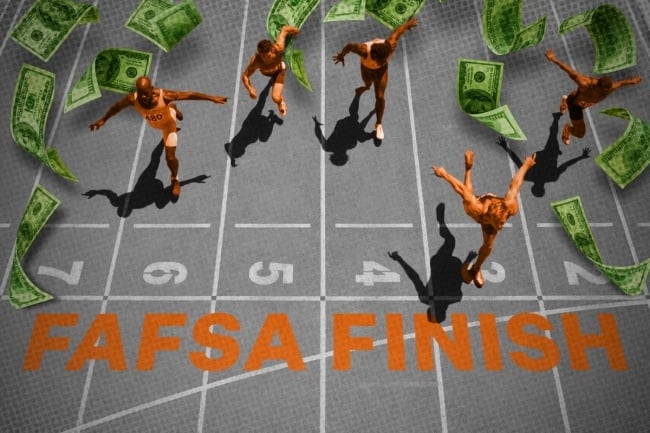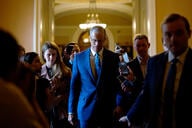You have /5 articles left.
Sign up for a free account or log in.

In some states, FAFSA completions are down as much as 15.7 percent, as of Aug. 16, compared to this point last year.
Photo illustration by Justin Morrison/Inside Higher Ed | Chris Ryan/Getty Images
In West Virginia, billboards declare that students should fill out the Free Application for Federal Student Aid and “fetch funds for college fast.” In Alabama, students who have yet to finish the form are receiving direct text messages reminding them to complete their FAFSA. In Mississippi, dozens of businesses, churches and nonprofits are hosting events to help students with the application.
States across the country have worked all summer on a final push to boost FAFSA completion rates, which have dropped this year due to the U.S. Education Department’s botched launch of the revamped form. State officials and college-access professionals say their efforts, backed by a $50 million infusion from the Education Department, have helped to move the needle, but they don’t expect to catch up to last year’s application numbers.
“The hole that students were in over all was so deep that it’s very hard to climb out … over the course of the summer,” said Bill DeBaun, senior director of data and strategic initiatives for National College Attainment Network, a nonprofit. “Closing the gap is out of the question.”
Nationally, applications from recent high school graduates are down by about 9.5 percent, as just over half of the Class of 2024 has completed the form, according to the National College Attainment Network’s FAFSA tracker. In states, FAFSA applications are down anywhere from 1 percent to nearly 16 percent. (The Education Department says that the total gap in FAFSA submissions is 3 percent, but that includes all students, not just high school seniors.)
Although the gap has narrowed over the last several months—from nearly 40 percent in late March to 13.5 percent at the end of May—progress slowed during the summer months—a time when the Education Department, higher education leaders and others hoped to make up lost ground.
“There’s a lot of great programming that’s going on out there in the field right now, [but] it does rely on students and families availing themselves of it,” DeBaun said. “ In some cases, we’re not seeing droves of students and families coming and taking advantage of the programming.”
But DeBaun and others aren’t giving up yet, even as some colleges have already started classes and the next FAFSA cycle looms. The 2024–25 FAFSA is open until June 30, 2025, and students can still opt to start in the spring semester or enroll in at community colleges that have rolling admissions or programs that start later in the fall.
To help, the Education Department said in May that it would hand out funds to states, colleges, college-access groups and other organizations for efforts to boost FAFSA completion rates. So far, $43 million has been disbursed to more than 300 entities across the country, according to an ED spokesperson.
Across the country, organizations and states have used that money to raise awareness about the form, to hire more staff who can reach out directly to students and to host FAFSA completion events, among other uses. In Kentucky, state officials held a 12-hour FAFSAthon. Other groups have held raffles as a way to entice students to come to a FAFSA event.
Here’s how groups in three states—Alabama, Mississippi and West Virginia—worked to boost FAFSA completion this summer.
Staffing Up in Alabama
It’s been a busy summer for Chandra Scott, executive director of the college access nonprofit Alabama Possible. The organization, which runs a FAFSA help desk, has fielded 167 phone calls. Last year, they received 131 calls for the entire year. When staffers on the help desk aren’t answering those calls, they are reaching out directly to students who started but didn’t complete the FAFSA.
Applications in Alabama are down by about 15.5 percent. That’s one of the largest gaps in the country, but it has shrunk by about 5.9 percentage points since the end of May as the application rate ticked up 7.9 percentage points. So far, 52.1 percent of the high school Class of 2024 has completed the FAFSA, which ranks Alabama among the top 20 states.
“At least we know we’re going in the right direction, and our efforts are paying off,” Scott said, though she’s not expecting the completion gap to close much further.
Alabama Possible received about $250,000 from the Education Department’s FAFSA fund, which it spent on staffing up its help desk and ramping up marketing efforts about the application. Scott said that organizations like hers fill in the gap for students who don’t have access to their counselors once schools close for the summer, so having the money to hire more counselors was critical.
“Giving us the ability to meet the needs of those students and those families has paid off in dividends,” she said. “It shows in our FAFSA completion numbers.”
‘Tenacity’ in Mississippi
Nearly 60 percent of graduating seniors in Mississippi have completed the FAFSA. The state’s completion rate—58.3 percent—ranks the highest among the states. At the end of May, the state had ranked 15th, as only 44.3 percent had filled out the form.
Mississippi saw some of the nation’s highest gains this summer in terms of closing its gaps and boosting completion rates. Even so, applications are down by 13.4 percent from last year.
Historically, Mississippi’s FAFSA completion rate is near the top. Last year, nearly 70 percent of the state’s graduating seniors completed the form. This year, cracking 60 percent would be a success, said Kierstan Dufour, director of external training and partnerships at the Woodward Hines Education Foundation, a college-access organization that offers one-on-one support to students and families as they complete the application.
Woodward Hines received $379,000 from the Education Department for FAFSA completion events. Dufour said that’s funded 70 community events across the state, including one on Monday, at churches, businesses and schools. The foundation also expanded its hours, partnered with community colleges and ran radio ads, including on different religious stations, to let students in rural areas know they could get money for college by filling out the FAFSA.
“Tenacity is what we’re doing,” Dufour said.
The summer increase in FAFSA completions was expected, she said, because Mississippi students depend heavily on the Pell Grant. “We’re a poor state, so we naturally need to have the FAFSA completed,” she added.
Dufour attributed this summer’s “dramatic” increase to a collective effort across nonprofits, schools and businesses to support students with the application. The additional funding helped as well. Without it, the organization wouldn’t have been able to run ads or offer appointments in the evenings or on weekends.
“We would have been able to do only a very small fraction,” Dufour said. “We would have still chipped away at it. We would have still held appointments, but it would have been in a center or virtually in the traditional 8-to-5 hours. This allowed us to quadruple the influence of advisers to students across the state.”
Declaring an Emergency in West Virginia
Sarah Tucker, chancellor of the West Virginia Higher Education Policy Commission, closely watched the state’s FAFSA completion rates as students struggled to access the glitchy application. When the rate wasn’t increasing, she went to Governor Jim Justice, who later declared a state of emergency over the FAFSA issues at the end of April. At the time, applications were down by about 40 percent from the previous year.
The declaration suspended FAFSA requirements for state financial aid programs. Typically, students would have to complete the form in order to access state funds such as the merit-based Promise scholarship, under which eligible students can receive up to $5,500. About 43,540 students have since received the Promise scholarship or state grant aid, up from 31,867 students in the previous year, Tucker told state lawmakers over the weekend.
Tucker told Inside Higher Ed that the emergency declaration spurred “even more dramatic changes.” Enrollment numbers at state colleges ticked up, along with deposits from students to secure their spot. West Virginia lawmakers built on the emergency declaration in May, sending more than $80 million to the state’s colleges and universities to shore up their budgets and provide direct support to students. Through it all, Tucker’s office continued to host FAFSA workshops—more than 200 so far—and reach out to students to raise awareness.

West Virginia officials launched a marketing campaign, including this billboard, to include students to fill out the aid application.
West Virginia Higher Education Policy Commission and the West Virginia Community and Technical College System
The state used a $500,000 grant from the Education Department to launch an advertising campaign that included digital, television and radio ads as well as billboards that were placed along interstates and some smaller roads.
Through Aug. 16, about 50 percent of West Virginia high school seniors who graduated this year have completed the form. Still, applications are down by nearly 16 percent from the previous cycle—the highest gap in the country, according to NCAN. That gap has narrowed since the end of May, when applications were down 20.8 percent. To catch up to where the state was at this point last year, Tucker said 6,000 more students would have to complete the application.
“Six thousand students in a state like West Virginia is a heck of a lot of students,” Tucker said. “I do think these things have helped significantly, and there’s a big bump there in June when, you know, all of these different initiatives took place. Compared to where we were in February and March, I’m much more confident that everything we have done has had an impact and will continue to have an impact.”
But Tucker worries about the students who haven’t filled out the FAFSA and won’t end up in the workforce. That group, which she said is “too large,” has been a focus of hers. But she knows boosting the college-going rate is “an uphill battle.”
“We’ve got to figure out how to get more students to think about what their options and opportunities are,” she said. “If it’s the military, great. If it’s a great-paying job, great. If it’s going to college, great, but they have to do something … I think probably one of the reasons that I reacted as strongly as I did about the FAFSA was because this is just another obstacle for those kids that we’ve worked so hard to try to get to go to college.”




